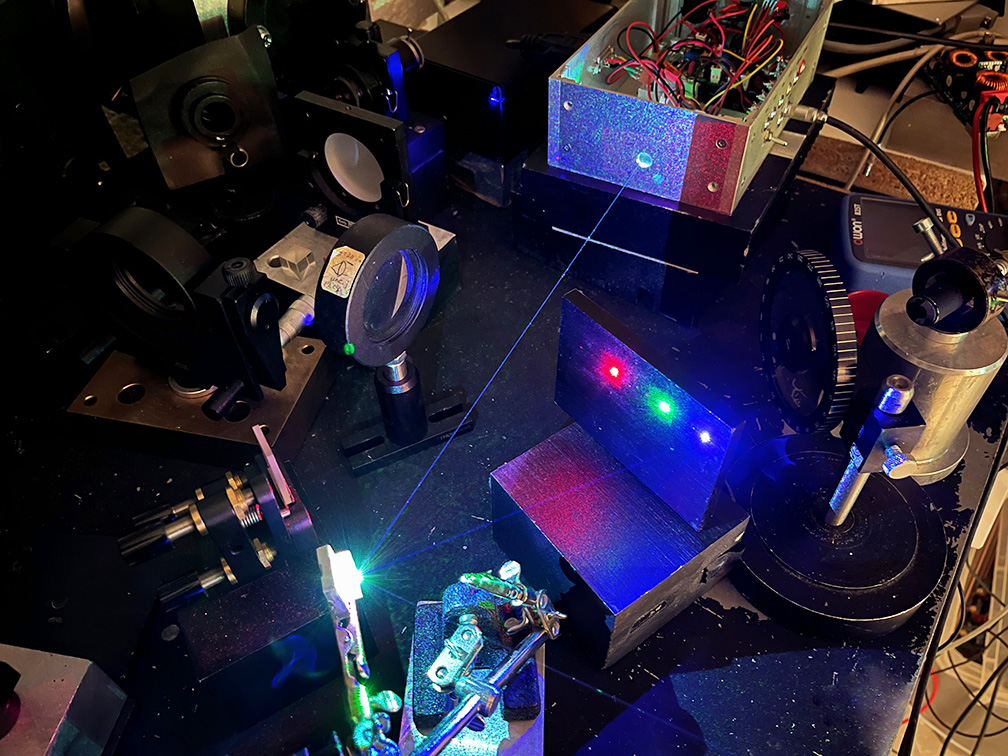
Back to PL530 page
Return to home page
With a delay of a few years relative to the thorough discussion at the Holography Forum, I finally had a closer look at those "white light engines". Thanks go to Dave B. for supplying a couple. These neat little devices feature RGB lasers, the green one being the famed PL530, while the red and blue ones are simple laser diodes. Naturally this leads to trying this setup for using it as a three-color holography laser, and some success has been reported at the forum. A potential big bonus is the good collimation and alignment of the three beams into a white one. Note that the PL530 is vertically, while the red and blue diodes are horizontally polarized.
Since much has been said already in that thread, I don't need to repeat it here. All what I like to add is an analysis of the spectral properties of the red and blue lasers. The green one has been extensively discussed in my writeup, from the viewpoint of a standalone green laser. Thus here I focus on the extra features of the white light engine.
There are a few potential pitfalls with this laser.
The most severe one is that the red and in particular blue diode lasers do not naturally run at single longitudinal mode. This is why I performed tests for two units and will summarize them below.
Another one is that all three lasers are thermally coupled, and this means, modifying the current of one laser (say, to restore single mode operation), it may have an influence on the other lasers (eg., kicking another one out of single mode operation). This requires a very well designed temperature control setup, and probably this would require several iteration steps for the unit to be practically useful for holography, if at all. So far I just press-mounted the device against a 2.5mm alu plate that by itself sits on top of the TEC peltier element, see below. The thermistor for temperature control is embedded into this plate, being as close as possible to the TEC element for stability.
Here it is in operation in my test rig:
While the three beams appear surprisingly well collimated and centered, it is not guaranteed that it is good enough to fit through a spatial filter. Below an attempt to get all three colors through a spatial filter: only red and blue fit nicely together. The problem here is that the optics is not really adjustable. Likely the alignment varies between devices and potentially, with some luck, one can find a sample that centers better. On the other hand, using a spatial filter with free-running laser diodes is anyway prone to instabilities due to unavoidable back reflections.
Moreover I don't know what types the red and blue diodes are and therefore their operation limits are unknown. On the other hand, single mode operation happens at low powers anyway (if at all), so I limited the current for the diodes to about 120mA for testing.
I won't address for now any of those points other than the first one and will just present a few spectral measurements. These were done with my brand new automated measurement setup.
I
got two three units and naturally, at the very first try I killed the red diode of the first unit by a most stupid mistake. Thus all what remains to present for the first White Light Engine are the data for the blue diode (PL530 being not interesting in this context). The generic spectrum is a mess, as it is typical for blue diodes:
Here a systematic scan of linewidth, power and noise over diode current and temperature:
As always, purple or blue in the line width plot would indicate single longitudinal mode behavior, and evidently there is not such a zone beyond very few mW, for this device. This is in line with practically all blue laser diodes which generically tend to lase strongly multi-mode (unless an external grating is used). So this sample is quite useless for holography.
For the other White Light Engine module, the situation is slightly better:
There is a narrow zone of single mode operation at about 20mW, at 70mA and 19C. If is unclear whether this would be of any practical use, as the laser is prone to drift out over time, and also the slightest back reflections will destabilize it. At any rate operating the blue diode there would require a concurrent monitoring of the spectrum.
Quite better, on the other hand, fares the red diode:
While are there tight spots at about 30mW, a more safe broad region with single mode operation exists at round 90mA and17C at about 20mW. Here another view, where the color signifies output power and the height the line width:
Here is the data for the blue diode of the third White Light Engine I got (thanks Loic!):
and the red one:
This is similar to the red diode of the second white light engine, and the pattern seems generic. One peculiarity is that the single mode region around 18C/90mA has lots of noise, in fact one can see minor side peaks in the spectrum analyzer that fluctuate chaotically. This give a strong hissing noise in the audio. Not sure whether this is harmful for holograms, as these side peaks are quite suppressed.
In summary: the White Light Engines might be definitely useful for red-green operation near 20mW when suitably adapting the power of the PL530. Blue remains a problem.
Version history
Current: Vers. 1 Feb 2022
Return to home page